Solar (PV) inverters convert the DC voltage generated by solar panels into AC voltage, which can be used in public power grids and commercial appliances. The optical coupler is an important part of this process, because it can prevent high voltage and transient voltage caused by component damage or transmission distortion during the conversion process. This article will discuss design techniques to improve the power buffering of optocouplers to make them less susceptible to noise interference.
Optocoupler assisted arm power solar inverter reliability increased
In the process of converting sunlight into energy, solar panels usually produce a high-voltage DC output. Converting the DC output into a high-voltage AC output minimizes line losses and allows long-distance transmission of the output power, either to the power company grid or to the internal grid of the building where solar panels are installed. The conversion of direct current to alternating current (DC-AC) is performed by a subsystem called a solar inverter, which can be designed as a single solar panel or as a central unit for converting solar panel arrays.
If the solar inverter is installed on a single solar panel, this is called a micro-inverter (Figure 1), this is a smaller solution, suitable for residential and general buildings, the power of its solar panels can be directly used for construction Internal network and commercial appliances. In this case, the working power of the inverter is usually less than 300 watts (W).

Figure 1 Micro-inverter architecture installed on a single PV board
When a solar inverter is used as an independent unit that supports several PV panels, it is called a Central Inverter (Figure 2). Its block diagram is essentially the same as a micro inverter, except for one more battery system. , Can store the energy of multiple solar panels, and then sent to the public power grid. The working voltage of the central inverter is generally 1 kilowatt (kW) or above.

Figure 2 Central inverter architecture supporting PV panel array
When the optocoupler is integrated into the module that drives DC-DC and DC-AC converters, as shown in Figure 1 and Figure 2. In these two types of solar inverters, the optocoupler is an important part of the system, which can prevent the high voltage and transient voltage at one end of the line from causing damage to the components at the other end or transmission distortion.
When used to isolate high noise, high voltage and high current circuits from low voltage control circuits, optocouplers can improve performance, make printed circuit board (PCB) sizes smaller, and circuit design easier. Isolating high-voltage components from low-voltage control circuits also helps protect grid employees or maintenance personnel who install, operate, or repair solar inverters.
Suitable for the gate drive optocoupler of solar inverter, it can drive high-speed metal oxide semiconductor field effect transistor (MOSFET) and insulated gate bipolar transistor (IGBT), and can optimize the starting performance and improve the noise immunity .
Gate drive optocoupler capable of driving 1,200 volts (V) / 20 amps (A) IGBT and MOSFET, its high level of common mode rejection (CMR) makes the noise immunity stronger; 100 nanoseconds (ns) The pulse width distortion (PWD) can improve power efficiency and allow designers to use smaller filters, thereby reducing design size and cost. The PWD level supports 1,414V peak operating voltage to meet 1,200V IGBT switching.
Briefly describe the operation mode of optocoupler
It can be used as an optocoupler to control the power buffer of the power MOSFET or IGBT gate. In the form of positive voltage (VOH), it provides the peak charging current for the gate of the power semiconductor to turn on the device. The optocoupler pulls the gate of the drive device to zero voltage (VOL) or lower to close the gate.
MOSFETs or IGBTs are usually arranged in a half-bridge topology configuration. The drain of each high-side N-channel MOSFET / IGBT is connected to the positive electrode of the power supply, and each source is connected to the low-side transistor. The source of the low-side transistor is connected to the negative electrode of the system power supply.
Fig. 3 is an internal block diagram of the optical coupler. Each part of the driver is powered by a common power supply or a bias power supply. During the startup process, when the power is turned on for the first time, the complexity of the circuit will cause a delay, which will cause the gate output to continue to increase with the VDD power supply; it will continue to rise until the power supply is stable. Then, once the bias voltage is correct, the gate driver output returns to the correct state controlled by the light emitting diode (LED).
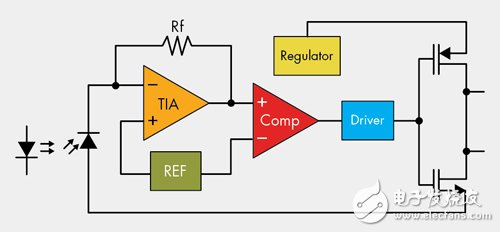
Figure 3 Block diagram of optocoupler
Setting the power-on sequence can minimize the impact of waiting for the optocoupler bias power supply to stabilize. Solar inverters usually have three power supplies, a logic power supply (3.3, 5 or 10V), a photocoupler power supply, and a high-voltage power supply to power the MOSFET / IGBT. Turn on in order according to the order of power supply, firstly logic power supply, then optocoupler power supply, and finally MOSFET / IGBT power supply. In this way, it helps to offset the effects of a stable bias power supply. This turn-on sequence also satisfies the logic-controlled power-on reset and Bootstrap charging time of the isolated driver power supply.
For LED drivers, the forward current peak IF "1A (1 microsecond (μs), 300pps). The recommended operating current is 10? 16 milliamperes (mA). The current rise time is less than 250 nanoseconds (ns). This feature minimizes transmission delay and reduces output switching jitter.
A high-gain (23dB), high-power output optical amplifier requires a low-impedance power supply up to 40MHz beyond the DC range; the use of low ESR bypass capacitors and signal ground planes can help reduce spontaneous power noise and prevent output rise And decay time.
Common mode rejection is a measure of noise
High-frequency transients become a type of noise, which may damage the data transmission of the isolation barrier of the optocoupler. CMR is a measure of the ability of optocouplers to withstand transient noise. CMR is one of the most important indicators to measure the performance of optocouplers. Other indicators include isolation level and operating voltage.
The eight-pin DIP coplanar (Coplanar) structure of the optical coupler can provide output capacitor high dielectric (Dielectric) insulation and low input. The eight-pin DIP package allows a creepage and gap distance greater than 8 millimeters (mm) and an insulation distance of 0.5mm to achieve reliable high-voltage insulation.
Therefore, the gate driver optocoupler solution can provide more insulation safety buffers, while the insulation distance of capacitive or inductive solutions is less than 0.1mm. In this way, the safety is optimized and noise coupling is reduced. This device uses coplanar optical coupling technology to block the interference caused by electronic noise generated by load switching. There is also a special electro-optical shield to reduce the probability of capacitive coupling between the switching transient and the active circuit of the optocoupler.
Generally, a 240V AC power converter will generate 800V switching transients and a rotation rate greater than 6kV / μs. This large transient will cause a peak current of 3mA to flow between the input and output (for isolated devices with a CIO of only 0.5 picofarads (pF)). Figure 4 shows an example of a capacitively coupled noise current between the coupler's input and output.
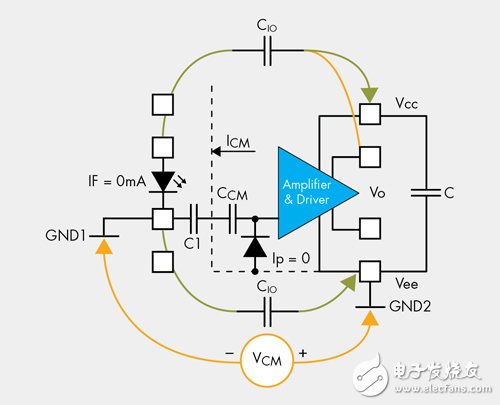
Figure 4 Current mode suppression LED "OFF"
Common mode transients have a negative voltage swing rate, the same as the coupler's output ground (GND2) reference; this transient can pull the coupler's output to the output; Package Capacitance, or CIO, provides input and output The main coupling impedance between; when the LED is off, the output of the gate is low; if there is sufficient common mode current iCM drawn from the input to the optical amplifier, the amplifier will be turned on.
The noise current iCM is extremely small because a special common-mode mask blocks the effects of changes in the electronic mask. This mask minimizes coupling into or out of the optical amplifier, limiting the effective common-mode coupling capacitance to less than 50pF . In this way, the optocoupler can easily suppress common mode transients with a maximum amplitude of 1.5 kV and positive or negative, and a rate of rotation exceeding 15 kV / μs.
When the control current of the IF is equal to 10mA through the LED, the driver output current is high and the source current flows to the load. Positive dv / dt will draw current from the amplifier to enhance the photocurrent; negative dv / dt will direct the current to the amplifier, offset the photocurrent, and may cause the amplifier to transition from high to low.
When IF is equal to 0mA, the driver input is low and current will be drawn from the load. Positive dv / dt will draw current from the amplifier and may cause the amplifier to transition from low to high. Negative dv / dt introduces current into the amplifier and helps maintain the amplifier's output low.
In general, reducing the coupling capacitance between the logic control and the power semiconductor as much as possible can greatly reduce the ability of common mode noise to become normal mode pulse noise. The use of low and balanced impedance at the driving point can improve the anti-interference ability. The use of Galvanic Isolated drivers for power MOSFET control can minimize common mode noise coupling.
Shunt LED improves the efficiency of half-bridge configuration
In the half-bridge topology configuration, common-mode transient suppression is particularly important because switching transients under normal current operation may cause the closed gate drive to open. Shunt LEDs come in handy, which improves the current mode transient resistance of the half-bridge configuration and maintains the load dv / dt coupling of the capacitors at low impedance-for LEDs that are running or BJTs that are running Or the on-state resistance of the logic gate. But the disadvantage of this method is that increasing the shunt LED drive will reduce efficiency, because this circuit consumes power regardless of whether the LED is turned on or off. Figure 5 shows a sample configuration.
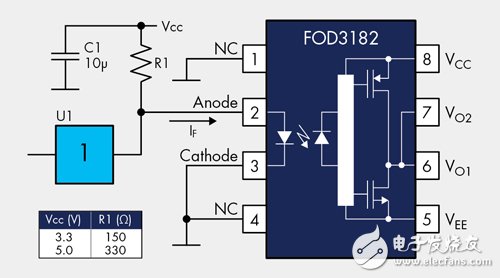
Figure 5 Optocoupler architecture with shunt LED driver
The LED is connected in parallel with the drive switch to form a current shunt drive. U1 is an open drain logic gate, used as a driver. When the switch is closed and U1 is high, there will be LED current. To turn off the LED, the gate must be forced to a low state, which will reduce the voltage across the LED to less than the required forward voltage value. It also provides low impedance and reduces the impact of common-mode conduction current on LED operation.
Understand the maximum switching frequency of the optocoupler
When using optocouplers, it is very useful to know the maximum switching frequency of the design. This calculation involves two basic steps. First, it must be determined that the maximum operating junction temperature of 125 ° C and room temperature of 100 ° C. The optocoupler output driver MOSFET can be diffused. Maximum power. Secondly, under the given charging and discharging current of the MOSFET gate, the diffused RMS power of the output transistor and the RDS (ON) voltage drop of the entire optocoupler transistor.
Solar inverters play an important role in generating and transmitting clean and sustainable energy. When performing DC-AC conversion, high-voltage current must be carefully and effectively isolated, and optocouplers are suitable for this type of power buffering. If you pay special attention to starting requirements and use related technologies to improve anti-jamming capabilities, you can help optimize the performance of the optocoupler.
The gate drive optocoupler described in this article is compatible with discrete power MOSFET and IGBT products. Therefore, designers can design the logic, isolation, and MOSFET parts of the power conversion circuit in a unified manner. This solution converts milliwatts (mW) to kW and provides isolation between the primary and secondary circuits.
Project lamps is based on the actual needs of the project, customized for the specific lighting products, it plays decorative effect, also known as non-standard lamps, decorative lamps, custom lamps and so on. Engineering lamps feature with custom, long production time, high production technology, strong professionallity , weak liquidity, highly difficult installation, after-sales service and so on.
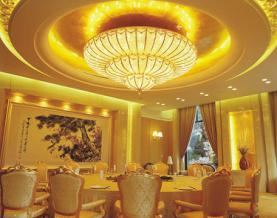
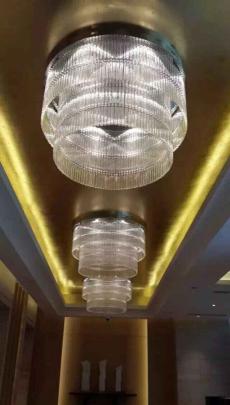

Project Lamp,Rechargeable Spot Light,Lobby Room Project,Airport Project
Zhongshan Laidi Lighting Co.,LTD , http://www.idealightgroup.com